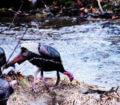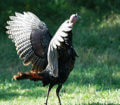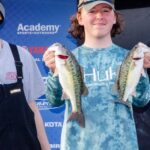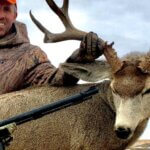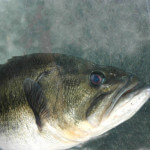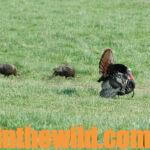Editor’s Note: Ernie Calandrelli just retired as the director of public relations and advertising for Quaker Boy Game Calls in Orchard Park (https://www.quakerboy.com), New York, and is an avid turkey hunter.
 If you hunt turkeys in the spring, you can expect to either get wet or stay in camp. I’m not a stay-in-camp person, so I’ll put-on my rainsuit, turkey vest and rubber boots and go to the turkeys. Actually I don’t do much differently when I’m hunting on rainy days from what I do on clear days. One of the biggest secrets for taking turkeys is learning all you can about the wild turkey. Turkeys eat, sleep, dodge predators and mate. When rain is pouring down, the turkey’s ability to see and hear predators in the woods is extremely limited. Therefore, when a turkey flies-off the roost on a rainy day, he’s usually headed for a field, a clear-cut or another open area where he can see 360 degrees around himself. If the turkey stays in the woods, the leaves and the branches are moving in the rain, and he can’t detect predators as well as he can in the open fields. When the rain stops, and the sun pops out, the turkey can dry his feathers better in an open place like a field than he can in the woods and thicker cover. On rainy days, I head straight for the fields, the clear-cuts and the open places, because that’s where turkeys want to be.
If you hunt turkeys in the spring, you can expect to either get wet or stay in camp. I’m not a stay-in-camp person, so I’ll put-on my rainsuit, turkey vest and rubber boots and go to the turkeys. Actually I don’t do much differently when I’m hunting on rainy days from what I do on clear days. One of the biggest secrets for taking turkeys is learning all you can about the wild turkey. Turkeys eat, sleep, dodge predators and mate. When rain is pouring down, the turkey’s ability to see and hear predators in the woods is extremely limited. Therefore, when a turkey flies-off the roost on a rainy day, he’s usually headed for a field, a clear-cut or another open area where he can see 360 degrees around himself. If the turkey stays in the woods, the leaves and the branches are moving in the rain, and he can’t detect predators as well as he can in the open fields. When the rain stops, and the sun pops out, the turkey can dry his feathers better in an open place like a field than he can in the woods and thicker cover. On rainy days, I head straight for the fields, the clear-cuts and the open places, because that’s where turkeys want to be.
I don’t call as much on rainy days, since turkeys don’t gobble as well when rain’s falling. I’ve had turkeys gobbling from the ground, and then they’ll shut-up as soon rain starts. Remember, when a turkey gobbles, he’s not only calling-in hens. He’s also notifying predators where he is. The turkey’s eyes are his number-one defense, and when the rain starts, he can’t see as well because of all the movement in the woods. He knows he’s more vulnerable, and he’ll stop calling. So, I only call sporadically during the rain, and expect turkeys to come to me without gobbling. I like to use a tube call, that’s loud and not affected by the rain. I also prefer to use waterproof box calls and high-pitched waterproof calls to penetrate through the wind and rain and reach out and touch that gobbler. Remember, if the turkey can’t hear the call, he can’t come to it.
 Most of the time, turkeys will stay in the middles of fields. So, when I set-up to call them, I usually set-up right off the field, just behind the first line of trees. I always want to be next to a tree that’s wider than my shoulders, so the turkey can’t silhouette me. If I have a blind, I can set-up right on the edge of the field. A quality total-concealment blind is a great turkey-hunting aid on a rainy day. You can lay your calls out and be ready to use different types of calls, as you need them.
Most of the time, turkeys will stay in the middles of fields. So, when I set-up to call them, I usually set-up right off the field, just behind the first line of trees. I always want to be next to a tree that’s wider than my shoulders, so the turkey can’t silhouette me. If I have a blind, I can set-up right on the edge of the field. A quality total-concealment blind is a great turkey-hunting aid on a rainy day. You can lay your calls out and be ready to use different types of calls, as you need them.
Turkeys won’t be excited about coming to your call on a rainy day. They know the closer they are to the field’s edge, the closer they are to danger. I usually wear Mossy Oak Obsession (www.mossyoak.com) camouflage, because it blends in anywhere I hunt, whether I’m hunting Eastern gobblers in my home state of New York, Rio Grandes in the wide-open spaces of Texas, Merriams in the mountains of Montana or Osceolas in the swamps of Florida.
 To learn more about turkey hunting, check out John E. Phillips’s book, “The Turkey Hunting Guides’ Bible,” available in Kindle and print at https://www.amazon.com/Turkey-Hunting-Guides-Bible-ebook/dp/B01ITWYY2K and from Audible at https://www.audible.com/pd/B07L14HS5J/?source_code=AUDFPWS0223189MWT-BK-ACX0-135445&ref=acx_bty_BK_ACX0_135445_rh_us. To get a free eBook, “The Turkey Gobbler Getter Manual,” go to https://www.dropbox.com/sh/ps7hp9vdlek764m/AACP4EjpWIPxf8azkeWajvsMa?dl=0.
To learn more about turkey hunting, check out John E. Phillips’s book, “The Turkey Hunting Guides’ Bible,” available in Kindle and print at https://www.amazon.com/Turkey-Hunting-Guides-Bible-ebook/dp/B01ITWYY2K and from Audible at https://www.audible.com/pd/B07L14HS5J/?source_code=AUDFPWS0223189MWT-BK-ACX0-135445&ref=acx_bty_BK_ACX0_135445_rh_us. To get a free eBook, “The Turkey Gobbler Getter Manual,” go to https://www.dropbox.com/sh/ps7hp9vdlek764m/AACP4EjpWIPxf8azkeWajvsMa?dl=0.

